The Japanese Sengoku period from the mid-15th to early 17th century was a time of nearly continual military conflict. Powerful military lords known as daimyōs, such as Oda Nobunaga, Toyotomi Hideyoshi or Tokugawa Ieyasu, struggled to unify Japan.[2] During the Sengoku period, because of constant warfare, many fortifications and castles were built. Archetypal Japanese castle construction is a product of the Momoyama period and early Edo period.[2]
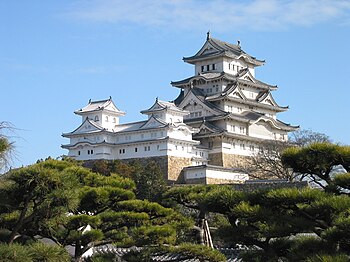
A new era of castle construction began when the daimyo Nobunaga built Azuchi Castle from 1576 to 1579.[3] Earlier fortifications of the Kamakura and Muromachi periods were crude large-scale structures; Azuchi, however, with rich ornamentation and a keep rising seven stories high, became the prototype for castle construction of the period.[4][5] The style of Azuchi Castle marked a shift in the function of the castles from a place that was merely a fortress and military garrison to a political, cultural and economic center. The newer style castles functioned as home to the daimyōs, his family, and his most loyal retainers. Because of the expense of building such a lavish structure, castles in the style of Azuchi, functioned also to highlight the power and prestige of the daimyōs.[2][6] These new castles were built of wood and plaster on a stone foundation. Generally the main keep or tenshu was positioned at the highest point, surrounded by a series of interlocking baileys with walls, small towers and pathways.[7] Residential buildings were located in one of the outer circles. The daimyō conducted his business in the citadel.[8]
Almost 100 major castles were built between 1596 and 1615.[5] The peak of castle-building occurred during the years 1600 to 1615: in 1600 Tokugawa Ieyasu defeated the Toyotomi clan in the Battle of Sekigahara; and in 1615 the Toyotomi forces were finally destroyed in the siege of Osaka.[2][9] The Tokugawa shogunate then limited the number of castles to one per province; and banned the building of new castles entirely in 1620.[2][9] By the time of the Meiji Restoration in the late 19th century, castles were in a state of disuse and neglect. Seen as symbolic of the ruling elite of previous eras, some castles were dismantled and sold as firewood. Others were destroyed by fire, earthquake or typhoon. Only twelve castles have a donjon that is considered original.[4]
The term "National Treasure" has been used in Japan to denote cultural properties since 1897.[10]The definition and the criteria have changed since the inception of the term. These castle structures adhere to the current definition, and were designated national treasures when the Law for the Protection of Cultural Properties was implemented on June 9, 1951. The items are selected by the Ministry of Education, Culture, Sports, Science and Technology based on their "especially high historical or artistic value".[11][12] This list presents fifteen entries of National Treasures from six castles built during the late Momoyama to early Edo period; however, the number of structures is actually more because in some cases multiple structures have been combined to form a single entry.[nb 1][nb 2] The structures listed include donjon, watch towers, goten (castle palace) [13]and connecting galleries.[12]
Features

The fifteen national treasures are distributed over six castles as follows: Nijo Castle has six national treasure structures, Himeji Castle has five national treasure structures; Hikone Castle, Inuyama Castle, Matsue Castle and Matsumoto Castle each have one. Three main types of castles exist. Generally the types are characterised according to the topography of the castle's site and named accordingly: mountain castles (山城, yamajiro); flatland castles (平城, hirajiro), as exemplified by Matsumoto Castle; and flatland mountain castles (平山城, hirayamajiro), which are castles built on hills in a plain such as Himeji Castle, Hikone Castle, Inuyama Castle, and Matsue Castle.[14]The donjon can be constructed in two ways. In the older bōrōgata (望楼型) style,[15] the top of the main keep is formed by a type of lookout tower placed on top of one or more hip-and-gable (irimoya) style roofs. Hikone Castle, Himeji Castle, Inuyama Castle and Matsue Castle are representative of this style. The sōtōgata (層塔型)[16] style represented by the keep of Matsumoto Castle has a virtually square foundation. Each level is slightly smaller than the one below but maintains the same shape.[17]
Only in rare cases the donjon stands independent of other structures. Generally it is connected to smaller watch towers called yagura, either directly (fukugōshiki (複合式)) or via a connecting gallery (渡櫓, watariyagura) in which case the style is called renketsushiki (連結式).[18][19] Matsumoto Castle has both styles, renketsushiki in the northwest and fukugōshiki in the southeast. At Himeji Castle three watch towers, four connecting galleries and the main donjon enclose a small courtyard.[17]A typical keep would have between three and seven stories discernible from the outside. Its inner structure including the number of floors could differ from the outward appearance.[20] Castle towers at Himeji, Inuyama, Matsue and Matsumoto Castle have one floor more than is visible from the outside.
Usage
The table's columns (except for Image) are sortable pressing the arrows symbols. The following gives an overview of what is included in the table and how the sorting works.
- Name: name of the structure as registered in the Database of National Cultural Properties[12][nb 1][nb 2]
- Castle: name of the castle in which the structure is located
- Construction: architecture and general remarks including the number of stories (outside) and floors (inside); the column entries sort by the type of structure (donjon, yagura, watariyagura)
- Date: period and year of the construction; the column entries sort by year. If only a period is known, they sort by the start year of that period.
- Location: "town-name prefecture-name" and geo-coordinates of the structure; The column entries sort as "prefecture-name town-name".
- Image: picture of the structure; If the image shows more than one structure, the respective structure is indicated by a blue rectangle.
Treasures
| Name | Castle | Construction | Date | Location | Image |
|---|---|---|---|---|---|
| Tenshu (天守)[nb 1][21] | Hikone Castle | donjon, three stories/three floors with an underground room and entry hall, hongawarabuki roof[ex 1] | Momoyama period, 1606 | Hikone, Shiga 35°16′35.21″N 136°15′6.64″E / 35.2764472°N 136.2518444°E |  |
| Connecting tower (附櫓, tsukeyagura) and Tamon Tower (多聞櫓, tamon yagura)[nb 1][21] | Hikone Castle | yaguras, each single-storied, hongawarabuki roof[ex 1] | Momoyama period, 1606 | Hikone, Shiga 35°16′35.74″N 136°15′6.68″E / 35.2765944°N 136.2518556°E |  |
| Big Tenshu (大天守, daitenshu)[23] | Himeji Castle | main donjon, five stories/six floors with a one-story basement, with hongawarabuki roof;[ex 1] connected to the ni-corridor in the west and the i-corridor in the north[nb 3] | Momoyama period, 1608 | Himeji, Hyōgo 34°50′21.66″N 134°41′38.67″E / 34.8393500°N 134.6940750°E |  |
| Northwest Small Tower (乾小天守, inui kotenshu)[24] | Himeji Castle | donjon three stories/four floors with a one-story basement, with hongawarabuki roof;[ex 1] connected to the ro-corridor in the east and the ha-corridor in the south[nb 3] | Momoyama period, around 1609 | Himeji, Hyōgo 34°50′22.57″N 134°41′37.72″E / 34.8396028°N 134.6938111°E | 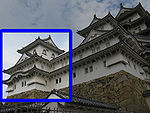 |
| West Small Tower (西小天守, nishi kotenshu)[25] | Himeji Castle | donjon three stories/three floors with a two-story basement, with hongawarabuki roof;[ex 1] connected to the ni-corridor in the east and the ha-corridor in the north[nb 3] | Momoyama period, around 1609 | Himeji, Hyōgo 34°50′21.83″N 134°41′37.62″E / 34.8393972°N 134.6937833°E |  |
| East Small Tower (東小天守, higashi kotenshu)[26] | Himeji Castle | donjon three stories/three floors with a one-story basement, with hongawarabuki roof;[ex 1] connected to the ro-corridor in the west and the i-corridor in the south[nb 3] | Momoyama period, around 1609 | Himeji, Hyōgo 34°50′22.45″N 134°41′39.11″E / 34.8395694°N 134.6941972°E | 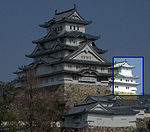 |
| I, Ro, Ha, Ni-corridors (イ, ロ, ハ, ニの渡櫓, i, ro, ha, ni no watariyagura)[nb 3][nb 4][27] | Himeji Castle | two stories/two floors with a one-story basement, hongawarabuki roof;[ex 1] I-corridor: between Big Tenshu and East Small Tower, 9.03 metres (29.6 ft) high on a 8.88 m (29.1 ft) high stone wall | Momoyama period, around 1609 | Himeji, Hyōgo 34°50′22.06″N 134°41′38.25″E / 34.8394611°N 134.6939583°E |  |
| Tenshu (天守)[28] | Inuyama Castle | donjon, three stories/four floors with a two-story basement, ca 25 m (82 ft) high, with hongawarabuki roof.[ex 1] There are single-storied watchtowers with hongawarabuki roofs on the south and west side | Momoyama period, 1601 | Inuyama, Aichi 35°23′18″N 136°56′21″E / 35.38833°N 136.93917°E |  |
| Tenshu (天守)[nb 5][29][30] | Matsue Castle | donjon, four stories/five floors with an underground room, hongawarabuki roof[ex 1] | Momoyama period, 1607–1611 | Matsue, Shimane 35°28′30.48″N 133°3′2.57″E / 35.4751333°N 133.0507139°E |  |
| Connecting tower (附櫓, tsukeyagura)[nb 5][29][30] | Matsue Castle | yagura, one story/one floor, hongawarabuki roof[ex 1] | Momoyama period, 1607–1611 | Matsue, Shimane 35°28′29.86″N 133°3′2.71″E / 35.4749611°N 133.0507528°E |  |
| Tenshu (天守)[nb 2] | Matsumoto Castle | main donjon, five stories/six floors, with hongawarabuki roof[ex 1] | Momoyama period, Bunroku era | Matsumoto, Nagano 36°14′19.03″N 137°58′7.87″E / 36.2386194°N 137.9688528°E | 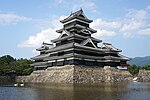 |
| Northwest Small Tower (乾小天守, inui Kotenshu)[nb 2] | Matsumoto Castle | secondary donjon, three stories/four floors, hongawarabuki roof[ex 1] | Momoyama period, Bunroku era | Matsumoto, Nagano 36°14′19.66″N 137°58′7.81″E / 36.2387944°N 137.9688361°E |  |
| Connecting Tower (渡櫓, watari yagura)[nb 2] | Matsumoto Castle | yagura, two stories/two floors, hongawarabuki roof[ex 1] | Momoyama period, Bunroku era | Matsumoto, Nagano 36°14′19.42″N 137°58′7.8″E / 36.2387278°N 137.968833°E | 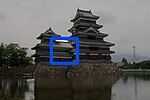 |
| Southeast Connecting Tower (辰巳附櫓, tatsumi tsukeyagura)[nb 2] | Matsumoto Castle | yagura, two stories/two floors, hongawarabuki roof[ex 1] | Momoyama period, Bunroku era | Matsumoto, Nagano 36°14′18.76″N 137°58′8.32″E / 36.2385444°N 137.9689778°E |  |
| Moon-viewing Tower (月見櫓, tsukimi yagura)[nb 2] | Matsumoto Castle | yagura, one-storied with one-storied basement, hongawarabuki roof[ex 1] | early Edo period, Kan'ei era | Matsumoto, Nagano 36°14′18.77″N 137°58′8.63″E / 36.2385472°N 137.9690639°E |  |
| Nijo Castle Ninomaru Palace and Waiting Room and Carriage Porch (二条城 二の丸御殿遠侍及び車寄, nijōjō ninomaru goten tōzamurai oyobi kurumayose) | Nijo Castle | goten waiting room building, one storied with tile roof and 'kurumayose' entrance with cypress bark roof | early Edo period, 1625-1626 | Kyoto, Kyoto | |
| Nijo Castle Ninomaru Palace Reception Room (二条城 二の丸御殿式台, nijoujou ninomaru goten shikidai) | Nijo Castle | goten reception hall structure, one-storied with tiled roof | early Edo period, 1625-1626 | Kyoto, Kyoto | |
| Nijo Castle Ninomaru Palace Great Hall (二条城 二の丸御殿大広間, nijoujou ninomaru goten oohiroma) | Nijo Castle | goten main hall structure, one-storied gable style with tiled roof | early Edo period, 1625-1626 | Kyoto, Kyoto | |
| Nijo Castle Ninomaru Palace Sotetsu Room (二条城 二の丸御殿蘇鉄之間, nijōjō ninomaru goten sotetsu no ma) | Nijo Castle | goten passageway structure, one-storied with tiled roof | early Edo period, 1625-1626 | Kyoto, Kyoto | |
| Nijo Castle Ninomaru Palace Black Drawing Room (Small Great Hall) (二条城 二の丸御殿黒書院(小広間), nijōjō ninomaru goten kuroshoin (ko hiroma)) | Nijo Castle | goten hall structure, one-storied gable style with tiled roof | early Edo period, 1625-1626 | Kyoto, Kyoto | |
| Nijo Castle Ninomaru Palace White Drawing Room (Throne Room) (二条城 二の丸御殿白書院(御座の間, nijōjō ninomaru goten shiroshoin (gozanoma)) | Nijo Castle | goten hall structure/throne room, one-storied gable style with tiled roof | early Edo period, 1625-1626 | Kyoto, Kyoto |  |
See also
Notes
- General
- Architecture
References
Bibliography
- Cluzel, Jean-Sébastien (2008). Architecture éternelle du Japon – De l'histoire aux mythes (illustrated ed.). Editions Faton. ISBN 978-2-87844-107-9. Retrieved 2011-07-20.
- Coaldrake, William Howard (1996). Architecture and authority in Japan. Nissan Institute/Routledge Japanese studies (illustrated ed.). Routledge. ISBN 978-0-415-05754-7. Retrieved 2009-11-22.
- Deal, William E. (2007) [1973]. Handbook to life in medieval and early modern Japan (illustrated, revised ed.). New York: Oxford University Press. ISBN 978-0-19-533126-4. Retrieved 2009-11-10.
- Nishi, Kazuo; Hozumi, Kazuo (1996) [1983]. What is Japanese architecture? (illustrated ed.). Kodansha International. ISBN 978-4-7700-1992-9. Retrieved 2009-11-11.
- Turnbull, Stephen; Dennis, Peter (2003). Japanese castles 1540–1640. Fortress Series. Vol. 5. Osprey Publishing. ISBN 978-1-84176-429-0. Retrieved 2009-11-11.

